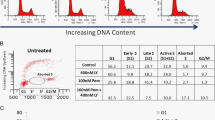Summary
Carmethizole hydrochloride [1-methyl-2-methylthio-4,5-bis(hydroxymethyl)imidazole-4′,5′-bis(N-methylcarbamate)hydrochloride, NSC 602 668; hereafter called carmethizole] is a new antitumor drug that has shown relatively broad activity in initial evaluations against several murine tumors and human tumor xenografts in vivo. The present studies were designed to address questions about carmethizole's activity against established disease, its activity on different treatment schedules, and the extent of its cross-resistance with established drugs. Human MX-1 mammary carcinoma, human NCI-H82 small-cell lung carcinoma, and human LOX amelanotic melanoma xenografts in athymic mice were used to determine the drug's activity against established disease; the NCI-H82 lung-tumor xenograft in athymic mice was used to explore its schedule dependence; and a series of drug-resistant murine leukemias provided an in vivo cross-resistance profile. When injected i.p., carmethizole exhibited antitumor activity against advanced-stage s.c. MX-1 mammary, s.c. NCI-H82 lung, and i.p. LOX melanoma xenografts and was as effective against established disease (MX-1 and LOX) as it was against early-stage disease (no data are available for early-stage NCI-H82). The therapeutic effect of carmethizole was not route-dependent, as was evidenced by the similar delays observed in tumor growth following i.p. and i.v. administration. The use of a split-dose schedule on a single day instead of one bolus injection yielded an increase in the total dose delivered, resulting in an increased delay in tumor growth. Murine leukemias resistant to vincristine (VCR), amsacrine (AMSA), or methotrexate (MTX) were not cross-resistant to carmethizole. However, murine leukemias resistant to doxorubicin (ADR), melphalan (l-PAM), cisplatin (DDPt), l-β-d-ara-binofuranosylcytosine (ara-C), and 5-fluorouracil (5-FU) were cross-resistant to carmethizole, suggesting that patients who have previously been treated with any of these agents might be less likely to respond to carmethizole than those who have had no opportunity to develop resistance to any of these compounds. We anticipate that the information derived from these studies may be useful in the design of clinical trials of carmethizole and may stimulate additional basic research on the mechanism of action of this new agent.
Similar content being viewed by others
References
Anderson WK, Bhattacharjee D, Houston DM, Plowman J, Harrison SD Jr (1988) Design, preparation, chemical properties and antitumor activity of carmethizole hydrochloride. Proc Am Assoc Cancer Res 29: 326
Anderson WK, Bhattacharjee D, Houston DM (1989) Design, synthesis, antineoplastic activity, and chemical properties of bis(carbamate) derivatives of 4,5-bis(hydroxymethyl)imidazole. J Med Chem 32: 119
Brockman RW (1974) Mechanisms of resistance. In: Sartorelli AC, Johns DG (eds) Handbook of experimental pharmacology, new series, vol 38/1. Springer, New York Berlin Heidelberg, p 352
Brodfuehrer JI, Wilke TJ, Kinder DH, Powis G (1989) Preclinical pharmacologic studies of the new antitumor agent carmethizole (NSC-602 668) in the mouse and beagle dog. Cancer Chemother Pharmacol 24: 277
Carney DN, Gazdar AF, Bepler G, Guccion JG, Marangos PJ, Moody TW, Zweig MH, Minna JD (1985) Establishment and identification of small cell lung cancer cell lines having classic and variant features. Cancer Res 45: 2913
Curt GA, Clendeninn NJ, Chabner BA (1984) Drug resistance in cancer. Cancer Treat Rep 68: 87
Deffie AM, Alam T, Seneviratne C, Beenken SW, Batra JK, Shea TC, Henner WD, Goldenberg GJ (1988) Multifactorial resistance to Adriamycin: relationship of DNA repair, glutathione transferase activity, drug efflux, and P-glycoprotein in cloned cell lines of Adriamycin-sensitive and-resistant P388 leukemia. Cancer Res 48: 3595
Deffie AM, Batra JK, Goldenberg GJ (1989) Direct correlation between DNA toposisomerase II activity and cytotoxicity in Adriamycin-sensitive and-resistant P388 leukemia cell lines. Cancer Res 49: 58
Developmental Therapeutics Program, Division of Cancer Treatment, National Cancer Institute (1984) In vivo cancer models 1976–1982. NIH publication 84-2635. U. S. Government Printing Office, Washington, D.C.
Elliott WL, Fry DW, Anderson WK, Nelson JM, Hood KE, Hawkins PA, Leopold WR III (1991) In vivo and in vitro evaluation of the alkylating agent carmethizole. Cancer Res 51: 4581
Harrison SD Jr, Brockman RW, Trader MW, Laster WR Jr, Griswold DP Jr (1987) Cross-resistance of drug-resistant murine leukemias to deoxyspergualin (NSC 356 894) in vivo. Invest New Drugs 5: 345
Kraker AJ, Moore CW (1988) Accumulation ofcis-diamminedichloroplatinum(II) and platinum analogues by platinum-resistant murine leukemia cells in vitro. Cancer Res 48: 9
Kraker AJ, Moore CW (1988) Elevated DNA polymerase beta activity in acis-diamminedichloroplatinum(II) resistant P388 murine leukemia cell line. Cancer Lett 38: 307
Lloyd HH (1977) Application of tumor models toward the design of treatment schedules for cancer chemotherapy. In: Drewinko B, Humphrey RM (eds) Growth kinetics and biochemical regulation of normal and malignant cells. Williams & Willkins, Baltimore, p 455
Redwood WR, Colvin M (1980) Transport of melphalan by sensitive and resistant L 1210 cells. Cancer Res 40: 1144
Schabel FM Jr, Griswold DP Jr, Laster WR Jr, Corbett TH, Lloyd HH (1977) Quantitative evaluation of anticancer agent activity in experimental animals. Pharmacol Ther [A] 1: 411
Schabel FM Jr, Skipper HE, Trader MW, Laster WR Jr, Griswold DP Jr, Corbett TH (1983) Establishment of cross-resistance profiles for new agents. Cancer Treat Rep 67: 905 (see correction, Cancer Treat Rep 68: 453)
Shoemaker R, Wolpert-DeFilippes M, Mayo J, Abbott B, Plowman J, Venditti J, Ovejera A, Donovan P, Griswold D, Dykes D, Boyd M, Fodstad O (1985) Experimental chemotherapy studies of a human melanoma in athymic mice using a survival endpoint. Proc Am Assoc Cancer Res 26: 330
Suzukake K, Petro BJ, Vistica DT (1982) Reduction in glutathione content ofl-PAM-resistant L 1210 cells confers drug sensitivity. Biochem Pharmacol 31: 121
Waud WR, Plowman J, Anderson WK, Dykes DJ, Harrison SD Jr, Griswold DP Jr (1989) Treatment route and schedule dependence and cross-resistance of carmethizole hydrochloride (NSC 602 668) in preclinical models. Proc Am Assoc Cancer Res 30: 615
Author information
Authors and Affiliations
Additional information
This work was supported by contract NO1-CM-07315 with the Developmental Therapeutics Program, Division of Cancer Treatment, NCI
Rights and permissions
About this article
Cite this article
Waud, W.R., Plowman, J., Harrison, S.D. et al. Antitumor activity and cross-resistance of carmethizole hydrochloride in preclinical models in mice. Cancer Chemother. Pharmacol. 30, 261–266 (1992). https://doi.org/10.1007/BF00686292
Received:
Accepted:
Issue Date:
DOI: https://doi.org/10.1007/BF00686292




